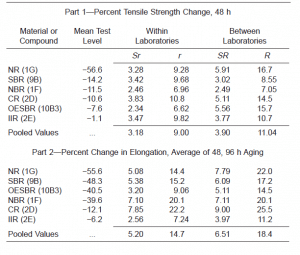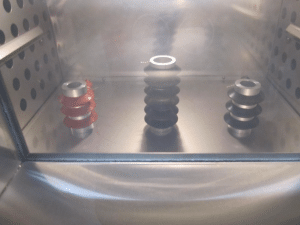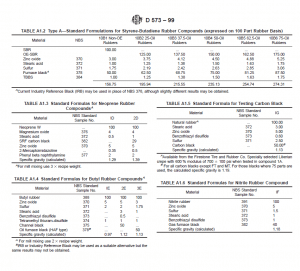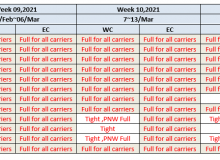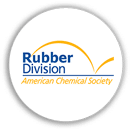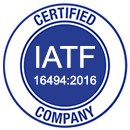Rubber Deterioration in an Air Oven – Test Method
Classification Systems are important for making good quality rubber products. ASTM – Rubber Guidelines are necessary in ensuring that proper values are not only repeatable but accurate in an lab environment. Coi Rubber also recommends other testings just as JIS, MILSPEC, and many other OEM guideline, however, a proper ASTM – Rubber Guildline must be first understood to properly engineer a component for your final application. Rubber tests on rubber Deterioration via ASTM test methods would be the best way to approach such standards.
Rubber generally conforms to possible deterioration due to many reasons. One could make a comparison of the aging of rubber compounds under tropical and other conditions. Two localities were chosen, one of which has a dry climate, the other heavy rainfall and high humidity. The results are compared with those obtained by ordinary lab tested oven aging and by other attributes at the same temperature, but with 100 per cent relative humidity. This artificial moist heat aging is found to be much more severe than the tropical moist aging, but it is not different in kind to aging in a lab oven and a simple conversion factor can be used to transpose and produce the results. Samples aged under dry conditions in the tropics are more influenced by bright sunlight, even though shielded from its direct rays, than by the heat aging. Recommendations are made concerning both the use of materials in the tropics and methods of accelerating aging to assess their behavior in the tropics.
What is Rubber Deterioration?
Two processes are of special importance in the preservation of rubber: oxidation, a chemical deterioration, and crystallization, a molecular restructuring that causes the material to loose its elasticity. Modern rubber, such as that found in NASA spacesuits, is highly susceptible to oxidation, and will slowly crystallize at room temperature.
Rubber can be preserved against oxidation by cold storage but only at the cost of considerably accelerating crystallization. However, it was found that such low temperature crystallization is reversible through heating, and that crystallization occurring at sufficiently low temperatures will be completely reversed by returning the object to ambient room temperature. This was found also to be valid for rubber that has already undergone significant chemical change through oxidation. Hence, cold storage provides an effective long-term preservation strategy for rubber.
What is also else does Rubber Deterioration cover?
1. Scope
1.1 This test method describes a procedure to determine the influence of elevated temperature on the physical properties of vulcanized rubber. The results of this test method may not give
an exact correlation with service performance since performance conditions vary widely. This test method may, however, be used to evaluate rubber compounds on a laboratory comparison basis.
1.2 The values stated in SI units are to be regarded as the standard. The values given in parentheses are for information only.
1.3 This standard does not purport to address all of the safety concerns, if any, associated with its use. It is the responsibility of the user of this standard to establish appropriate safety and health practices and determine the applicability of regulatory limitations prior to use. (For specific precautionary statement, see Note 1.)
Why it’s necessary:
- Sampling
6.1 The sample size shall be sufficient to allow for the determination of the original properties on three specimens and also on three or more specimens for each exposure period of the test. At least 24 h must elapse between completion of the vulcanization of the samples and the start of the aging test.
6.2 When minimum requirements are specified, one test on three dumbbells shall be considered sufficient. But if the results are below the specified requirements, two additional specimens shall be prepared from the original sample and tested. Should the results of either of these tests be below the specified requirements, the sample shall be considered to have failed to meet the specifications demonstrating rubber deterioration.
- Test Specimens
7.1 Dumbbell-shaped specimens prepared as described in Test Methods D 412 shall be considered standard. Their form shall be such that no mechanical, chemical, or heat treatment will be required after exposure. If any adjustments (for example, to thickness) are necessary, they should be performed prior to exposure.
7.2 The cross-sectional dimensions of test specimens for calculating the physical properties shall be measured prior to exposure in the aging chamber. Gage lines used for measuring elongation shall be applied after the specimens have been aged. Only specimens of similar dimensions having approximately the same exposed areas may be compared with each other.
- Number of Test Specimens
8.1 At least three test specimens shall be used to determine the original physical properties of each sample and also three or more specimens of the same material for each exposure period of the test.
8.2 When minimum requirements are specified, one test shall be made for tensile strength and elongation. If the results are below the specified requirements, two additional specimens shall be prepared from the original sample and tested. Should the results of either of these tests be below the specified requirements, the samples shall be considered to have failed to meet the specifications.
- Tests of Unaged Specimens of Rubber Deterioration
9.1 The stress – strain properties or tensile strength and ultimate elongation and any other required properties of the original unaged specimens shall be determined within 96 h of the start of the aging period. Results on specimens that are found to be imperfect shall be discarded and retests shall be made.
9.2 When rubber compounds are to be tested for the purpose of determining compliance with specifications, it shall be permissible to determine the original properties required in 9.1 simultaneously with the determination of the values after the first aging period even though the elapsed time exceeds 96 h.
- Procedure for Accelerated Aging
10.1 Place the specimens for aging in the oven after it has been preheated to the operating temperature. If possible, avoid simultaneous aging of a mixed group of different compounds. For instance, high-sulfur compounds should not be aged with low-sulfur compounds and those containing antioxidants shall not be aged with those having no antioxidants. Some migration is known to occur.
10.2 The operating temperature may be any elevated standard temperature as shown in Practice D 1349, as agreed upon. NOTE 1—Caution: It should be noted that, for each 10°C increase in temperature, the rate of oxidation may be approximately double. With rapid aging types of rubber or those containing or contaminated by certain oxidizing chemicals, the rate of oxidation may be catalyzed to such an extent as to become violent with increasing temperatures. This demonstrates rubber deterioration.
10.3 Start the aging interval at the time the specimens are placed in the oven and continue for a measured time interval. The selection of suitable intervals of aging will depend on the rate of rubber deterioration of the particular material being tested. Intervals frequently used are 2, 4, 7, and 14 days.
10.4 Use aging intervals such that the deterioration will not be so great as to prevent determination of the final physical properties. In experimental work, it is desirable to use a range of periods while for routine tests of known materials fewer intervals may be employed.
10.5 At the termination of the aging interval, remove the specimens from the oven, cool to room temperature on a flat surface, and allow them to rest not less than 16 h nor more than 96 h before rubber deterioration determination of the physical properties. Apply the gage lines to the specimens for use in measuring elongations.
Further Readings:
Another good place to start would be to contact our engineers at Coi Rubber or ASTM for further insight on this subject matter.
Have a question? Please fill out the form below to receive information regarding your inquiry. You may also give us a call at (626) 965-9966.
Error: Contact form not found.

